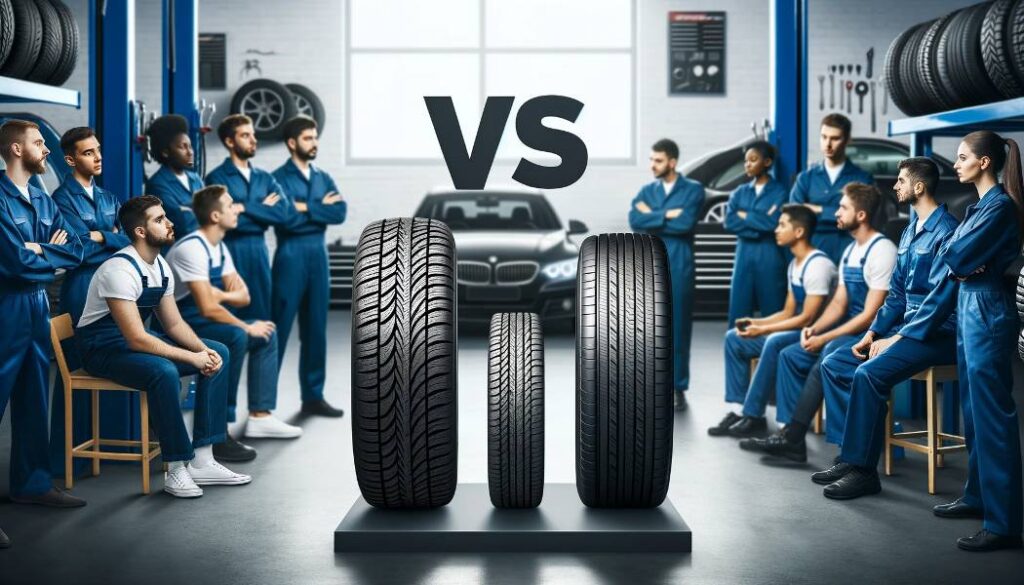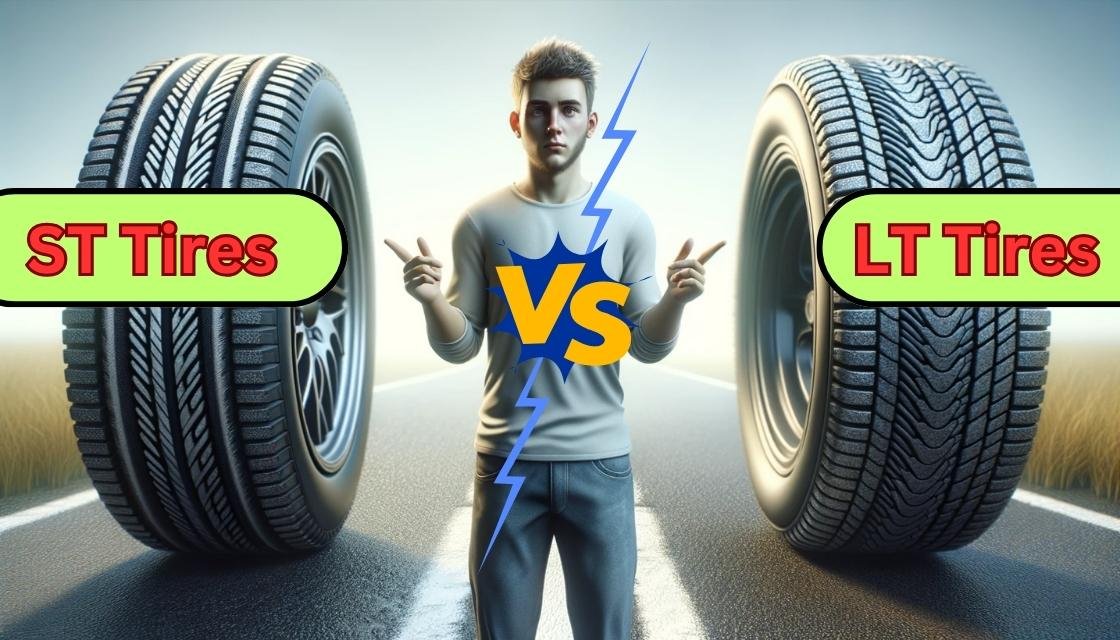You know that feeling when you’re stuck between two choices, and both seem right? Yeah, that’s the ST vs. LT tire dilemma for many. It’s not just about rubber; it’s about ensuring your vehicle runs smoothly, safely, and efficiently.
Think of it like choosing between two popular tire shops, each with its unique perks. But here’s the kicker: these tires aren’t interchangeable.
Making the wrong choice? It’s like paying extra for a warranty you didn’t need. This article is here to save you from that regret. We’re diving deep, highlighting the crucial differences, and ensuring you’re equipped to make the best decision.
Stick around; you won’t want to miss this.
ST vs. LT Tires: A Comprehensive Comparison

When it comes to choosing the right type of tire for your trailer or light truck, the debate between ST (Special Trailer) and LT (Light Truck) tires is a hot topic among automotive enthusiasts.
With a plethora of opinions and discussions on forums, it’s essential to understand the core differences between these two tire types.
Based on the information from our competitors, the video transcript, and expert insights, let’s break down the key differences and determine a clear winner for each aspect.
1. Purpose & Design
ST Tires:
- Specifically designed for trailer use.
- Prioritize stability and load durability.
- Not concerned with providing a smooth ride as they’re meant to be towed.
LT Tires:
- Designed for light trucks, SUVs, vans, and similar vehicles.
- Balance between durability and comfort.
- Meant to withstand heavier loads without excessive pressure build-up.
Winner: It’s a tie. Each tire serves its specific purpose. ST for trailers and LT for light trucks.
2. Construction & Durability
ST Tires:
- Heavier constructions with wider and stronger belt structures.
- Durable compound blends to prevent deformation under load.
- Thicker polyester cords and stronger steel wires.
LT Tires:
- Thicker sidewalls than passenger tires but not as thick as ST tires.
- Designed to dissipate heat under load while still providing some flex.
Winner: ST Tires. Their construction is more robust, specifically catering to the demands of trailers.
3. Handling & Performance
ST Tires:
- Optimal tire shape and firmer sidewalls for consistent surface contact.
- Designed to prevent trailer sway and provide stability with heavy loads.
LT Tires:
- Offer better traction and are more versatile in terms of comfort, traction, and handling.
Winner: LT Tires. They provide a more versatile performance, especially in terms of traction and handling.
4. Speed Rating & Safety
ST Tires:
- Most have a speed limitation of 65 mph, though some modern ones can handle up to 81 mph.
- Built to withstand high load pressure but not very heat-resistant.
LT Tires:
- Generally have a higher speed rating, often as high as 100 mph.
- Designed with heat-resisting properties.
Winner: LT Tires. Their higher speed rating and heat-resisting properties give them an edge.
5. Tread Design & Efficiency
ST Tires:
- Treads designed for low resistance, leading to better gas mileage and ease of towing.
- Harder rubber compound with chemicals resisting aging and UV rays.
LT Tires:
- More tread pattern choices.
- Designed with passengers’ comfort in mind.
Winner: ST Tires. Their tread design is more efficient for towing purposes.
6. Versatility & Use Cases
ST Tires:
- Specifically for trailers. Not recommended for any other use.
LT Tires:
- Suitable for light trucks, SUVs, and vans. Can be used for trailers, but not recommended.
Winner: LT Tires. They offer greater versatility in terms of where they can be used.
FAQs
Why might ST tires be recommended over LT tires for trailer applications?
ST tires are often recommended for trailers due to their specific design that caters to the unique needs of a non-powered axle. Here’s why they might be the better choice:
Sidewall Flex: ST tires are designed to minimize sidewall flex, which is a significant contributor to trailer sway. The stiffer sidewalls help the trailer to track more reliably behind the tow vehicle.
Load Carrying: They have a higher load-carrying capacity due to their construction, which is essential when you’re hauling significant weight.
Heat Dissipation: Trailers can generate a lot of heat in the tires, and ST tires are made with compounds that better dissipate this heat, reducing the risk of blowouts.
Speed Ratings: ST tires typically have a maximum speed rating of 65 mph, which aligns with safe towing speeds, thereby reducing the risk of heat-related tire failure.
Are there any situations where LT tires might be preferable on a trailer?
While ST tires are generally the go-to for trailers, there are instances where LT tires might be considered:
Frequent Use: If the trailer is used often and covers long distances, LT tires might offer better handling and a more comfortable ride.
Mixed Usage: For trailers that also need to navigate rough terrain, the traction and flexibility of LT tires could be beneficial.
Availability: In some regions, it might be easier to find replacements for LT tires, making them a more convenient choice for long-distance travelers.
What are the tread wear expectations for ST tires versus LT tires?
When considering tread wear expectations for ST (Special Trailer) tires versus LT (Light Truck) tires, it’s essential to understand that each is designed with a specific purpose and set of operating conditions in mind.
ST tires are constructed to be used on trailers, which means they are optimized for carrying heavy loads over long distances. They have stiffer sidewalls to handle the weight and prevent swaying. However, this design focus means that ST tires may not have the same longevity in tread life as LT tires. They are often built with a shallower tread depth since they don’t need the same level of traction as truck tires. The tread is designed to be stable and resist wear from long-distance hauling, but they are not made for the constant acceleration, deceleration, and turning that LT tires endure.
On the other hand, LT tires are designed to handle a variety of conditions, including off-road and on-road use, frequent starts and stops, and varying weather conditions. They are built with deeper tread depths to provide better traction and are likely to have more advanced tread compounds that can better resist wear over time. The tread patterns on LT tires are also more aggressive to handle the demands of light trucks, which typically engage in more dynamic driving than trailers.
How do the inflation requirements differ between ST and LT tires?
ST tires typically require higher inflation pressures compared to LT tires due to their design to carry heavier loads and to ensure the stability of the trailer. For instance, an ST tire might need to be inflated to around 65 psi, whereas an LT tire for the same size and load range might be rated at 50 psi. This difference is crucial for maintaining the tire’s integrity and optimal performance under load.
Final Thoughts
Choosing between ST and LT tires boils down to your specific needs. If you’re looking for tires specifically for a trailer, ST is the way to go. However, if you need versatility and are more concerned about traction, handling, and speed, LT tires might be more suitable.
Always remember to consider the load capacity, speed ratings, and the specific demands of your vehicle or trailer when making a decision. And as always, prioritize safety above all.

